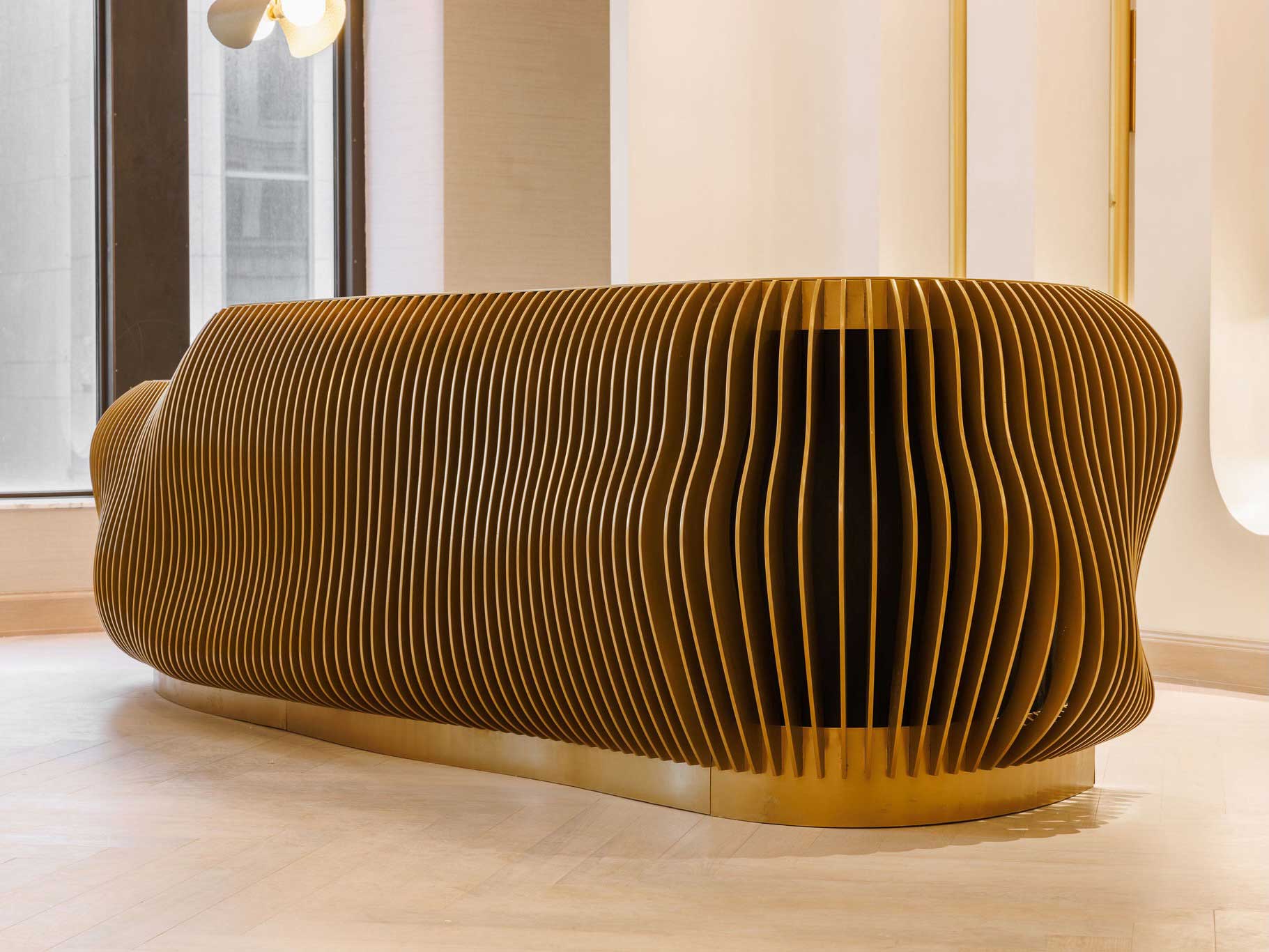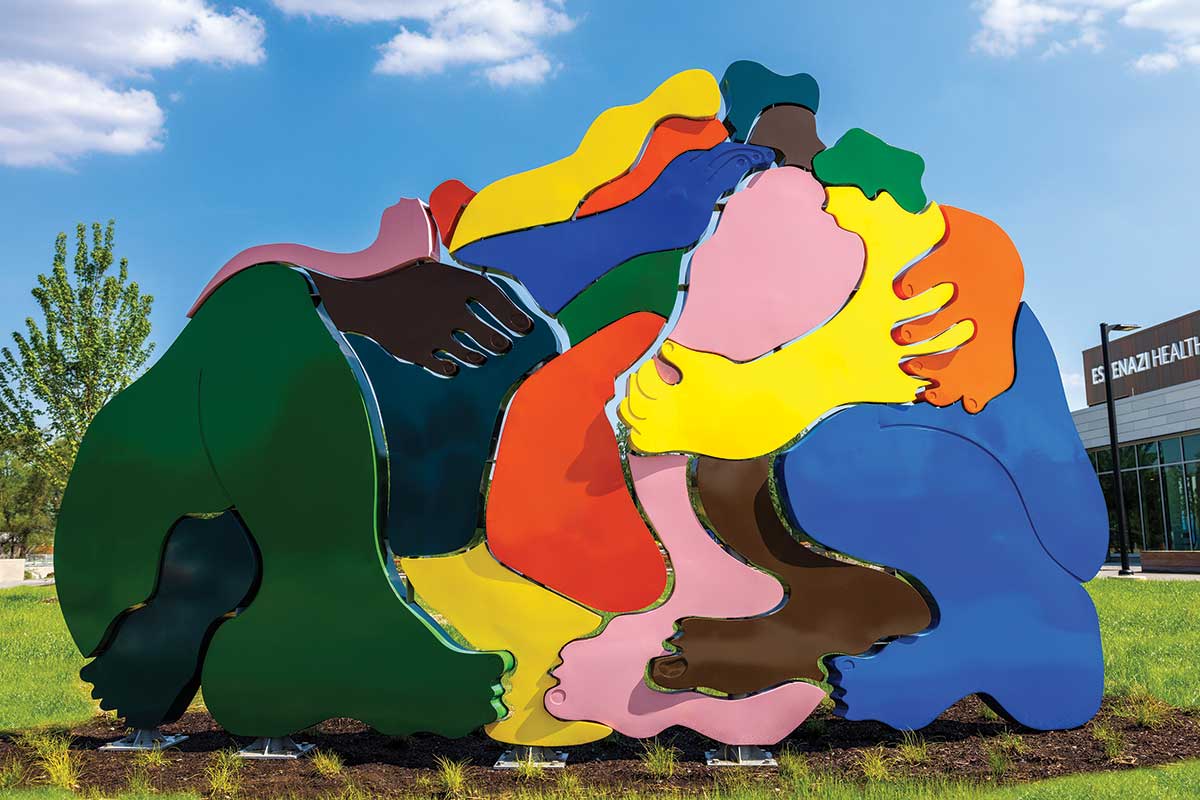The InterContinental Indianapolis is a hotel filled with commissioned and site-specific artwork, but no piece overshadows the reception desk fabricated by Indianapolis-based 900 North Studios.
Cory Constantine, who founded 900 North Studios in January 2020, said the brass-hued desk shaped like a cloud features 120 parametrically designed aluminum fins.
“The goal was to try to make it so that there were no visible welds or fasteners of any kind,” said Constantine, who credits Zack Hurst, 900 North’s lead fabricator, for bringing the design to tangible reality.
Constantine, who studied sculpture at Indiana University’s Bloomington campus, specializes in collaborating with fellow artists. Indianapolis-based artist Rebekah Nolan worked with 900 North Studios on her “Take Care” sculpture, which debuted in 2024 at the Eskenazi Health Thomas & Arlene Grande Campus, 6002 E. 38th St.
Constantine, 34, oversees a staff of 11 full-time employees and three part-timers at 900 North Studios, which occupies 12,000 square feet in a building near the intersection of East Washington Street and South Keystone Avenue.
He grew up in Irvington, and his family’s home in the 900 block of North Ritter Avenue inspired the name of 900 North Studios.
“The neighborhood we grew up in was just a really tight-knit community,” Constantine said. “About seven families on both the east and west sides of Ritter didn’t have extended families in the city, so we all kind of became each other’s extended families.”
Constantine said he works to have his old neighborhood’s sense of community and accountability carry over to the 900 North Studios workplace.
“Our core values are quality, collaboration, respect and trust,” he said.
Before Constantine launched his own company, he worked for two of the city’s top artists who lead fabrication firms: Ryan Feeney, the Indy Art Forge founder who made the sculpture of Peyton Manning displayed outside Lucas Oil Stadium, and Brian McCutcheon, the former co-owner of Indianapolis Fabrications and present co-owner of Ignition Arts who made the “NDY” sculptures that invite people to advertise Indianapolis by standing as the “I” in “Indy” while posing for photos.
Constantine spoke with IBJ about navigating the artistic and commercial sides of fabrication and the state of public art in Indianapolis. This conversation has been edited for length and clarity.
 The custom-designed hotel reception desk at InterContinental Indianapolis, 17 W. Market St., was fabricated by 900 North Studios. (Photo courtesy of 900 North Studios)
The custom-designed hotel reception desk at InterContinental Indianapolis, 17 W. Market St., was fabricated by 900 North Studios. (Photo courtesy of 900 North Studios) “Take Care,” a 2024 work by Indianapolis-based artist Rebekah Nolan, was fabricated by 900 North Studios. “Take Care” is displayed at the Eskenazi Health Thomas & Arlene Grande Campus, 6002 E. 38th St. (Photo courtesy of 900 North Studios)
“Take Care,” a 2024 work by Indianapolis-based artist Rebekah Nolan, was fabricated by 900 North Studios. “Take Care” is displayed at the Eskenazi Health Thomas & Arlene Grande Campus, 6002 E. 38th St. (Photo courtesy of 900 North Studios)
How did you launch your career in fabrication and design?
I applied to Indianapolis Fabrications when I graduated from college but did not get accepted there. Starting the Monday after graduation, I worked from 7 a.m. to 3:30 p.m. as a carpenter, doing rough framing of homes for a construction company. From 4 to 8 p.m., I worked for Ryan Feeney at Indy Art Forge, doing metal sculpture and architectural fabrication for him.
You then worked as a general technician at a backpackers campground in California, as shop manager for the Academy of Art University in San Francisco and as a construction worker in Colorado. What brought you back to Indianapolis?
I finally got a job with Brian McCutcheon at Ignition Arts, which had just started as a company. I thought at the time, “OK, I’m going to stay here for two years and learn everything I can. Then I’m going to leave Indiana and go try to make it as a sculpture artist in San Francisco, Denver or New York or somewhere like that.” I really liked working at Ignition, and two years turned into three years. At the end of that third year, I decided it was time to go off on my own.
Your company’s website showcases public art projects as well as commercial projects. How does 900 North Studios straddle or balance those worlds?
I always knew that trying to go straight into the world of large-scale public sculpture was going to be essentially a nonstarter and an impossibility if I wanted to have a financially healthy business. Pretty much everything the company did in the first two or three years was in the architectural space, whether that’s entry pergolas on homes, structural steel, decorative handrails, fireplace surrounds or elements for restaurants. That’s really where the business was, and that largely was out of necessity.
What helped to grow the artistic side?
I realized I needed someone to help me with that world, so I reached out to Mike Calway-Fagen, a former sculpture professor of mine at IU. After teaching sculpture at IU, he went on to teach sculpture as the head of the department at the University of Georgia. After that, he was instrumental in the founding of Stove Works artist residency in Chattanooga, Tennessee.
With his extensive background in the art world, I thought this might be the perfect person to come on board and help us to go through requests for submissions, the request-for-qualifications process and networking with artists. I brought him in, and we ended up getting a couple of large-scale projects in a matter of months. That was exciting.

Are you a fan of the Public Art for Neighborhoods initiative that requires real estate developers to set aside money for public art in Indianapolis?
I am. We’re doing a project under that with 1820 Ventures at the Gathyr apartment complex [at Elevator Hill in the 1100 block of East Market Street], collaborating with artist Shamira Wilson. … The Indy Arts Council just published that, per capita, Indianapolis spends $5.68 [annually] on the arts compared to Denver, which spends $103.64. Obviously, there’s a lot of work to be done there. Even if you go to a city like Cincinnati and walk around, the amount of public art shows cultural vibrancy and attracts people from outside the community into the community.
It’s unlikely that every person who’s an artist is also a great business owner or manager of employees. What personal traits help you thrive in the non-artistic parts of your job?
At a basic level, I’m really passionate about what I do here. Whatever challenges might arise or whatever information I don’t know or whatever skills I don’t have, I’m incredibly motivated to continue improving to achieve the goal of being a part of the large-scale public art world as well as to create beautiful pieces for architectural spaces.
When I started this business, I had no background in business. I still don’t have much of an idea of what I’m doing. I think that’s part of the excitement and frustration of being a business owner. When you meet a certain level of success and your business becomes bigger, your reward for that success is a period of extended failure. Now you have new sets of challenges and unknowns you have to figure out and deal with. So you get to fail for a while, and then you grow and you learn and you succeed. Then your success is rewarded with another series of failures and on and on.